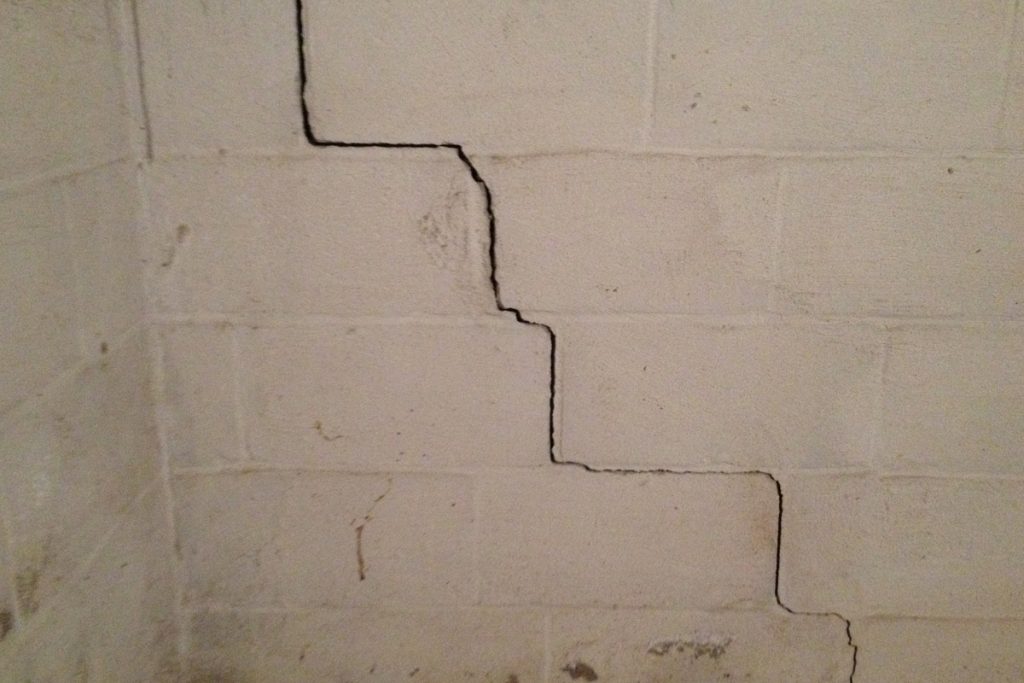Cracked foundation repair is a subject of great interest among homeowners because foundation cracks are often viewed as a serious defect despite being a very common occurrence in homes with poured concrete foundations.
Because of the potential seriousness associated with foundation cracks it is generally advised that foundation cracks be repaired whether they are leaking or not. Since many homeowners are concerned with how to repair foundation cracks I’ve written this blog post to provide relevant and related information such as why foundations crack, as well as the various available methods for properly fixing a cracked foundation.
Why foundations crack
The most common foundation cracks are caused by the shrinkage of concrete during the curing process. Since concrete is composed of water, cement and gravel it shrinks as it cures and dries. While drying, hardened concrete shrinks approximately 1/16 of an inch over a distance of 10 linear feet.
Concrete curing is affected by temperature; if its curing is interrupted by a significant temperature drop, for example overnight, the cured concrete will be affected because it contracts as it cools. On the other hand, when a foundation is poured in intense heat and sun, it can dry too quickly and crack because of thermal expansion.
Basement cracks are also created by the settlement of the soil beneath foundation walls. This can occur when your home’s footings aren’t wide enough or are damaged. Also, if the soil around your home is saturated with water, or if we haven’t had precipitation for quite a while, new problems may develop with the foundation. When the crack width exceeds 1/8 inch it is generally considered to be a “structural” crack.
When the soil is saturated the groundwater rises and exerts pressure against your basement walls (hydrostatic pressure); the associated soil pressure can cause basement wall cracks and the hydrostatic pressure causes basement leaks. During extended dry periods, the soil around your foundation shrinks as the water evaporates; this can cause your foundation to settle and often results in the development of one or more new basement wall cracks.
Horizontal cracking, usually observed on the upper part of the wall is usually caused by frost damage, and the freeze-thaw cycle. In most cases, water from your downspouts saturates the soil, as the soil freezes it exerts considerable pressure on the basement wall. In some instances horizontal cracking is caused by heavy equipment travelling too close to the foundation wall during backfilling.
How foundation cracks are repaired
In order to repair the types of foundation cracks described above, we employ one of the following three methods. These methods for foundation crack repair are: Epoxy crack injection, Polyurethane crack injection and finally, exterior crack repair.
Epoxy crack injection refers to the method of injecting a two-part glue into the crack from the surface of the crack. The epoxy is injected under pressure directly into the crack through injection ports that are installed at roughly one foot intervals from the bottom to the top of the crack. The material is injected sequentially from the bottom to the top until the crack is full and then begins to cure inside the crack forming a rigid material; essentially gluing the two walls together.
Polyurethane is the other chemical we use when injecting foundation cracks. Typically used in actively leaking cracks or cracks that have been repaired before; polyurethane is a resin that is injected into the crack from ports that are drilled beside the crack intersecting it halfway through the wall. The injection pressure for polyurethane is much higher than that of epoxy and the fact that polyurethane reacts with water makes it the method of choice when dealing with actively leaking or previously repaired foundation cracks.
Alternatively, there is the option of repairing the foundation crack externally. External crack repair is the traditional method of foundation crack repair. This method entails excavation down to the footing, cleaning the wall to expose the crack and applying a rubberized patch to the crack to cover it. While external crack repair is effective at preventing basement leaks it does have limitations, such as: it does not fill-in the crack, it is destructive to landscaping, its high cost relative to other repair methods, it is weather dependent and also takes several weeks to coordinate and have underground utilities located.
What it costs to repair a cracked foundation
The cost to repair a cracked foundation depends on the method of repair. General pricing is as follows:
Foundation crack injection (Epoxy or Polyurethane) price ranges from $500-$900 depending on the company.
When stabilization of a crack is required (ie. Crack is deemed structural and requires reinforcement), carbon fiber reinforcement staples are applied at a cost of $75 each. Most cracks of average length require 3 staples.
The cost of exterior crack repair typically starts at around $1800-$2000 per crack but could increase depending on ease of accessibility.
